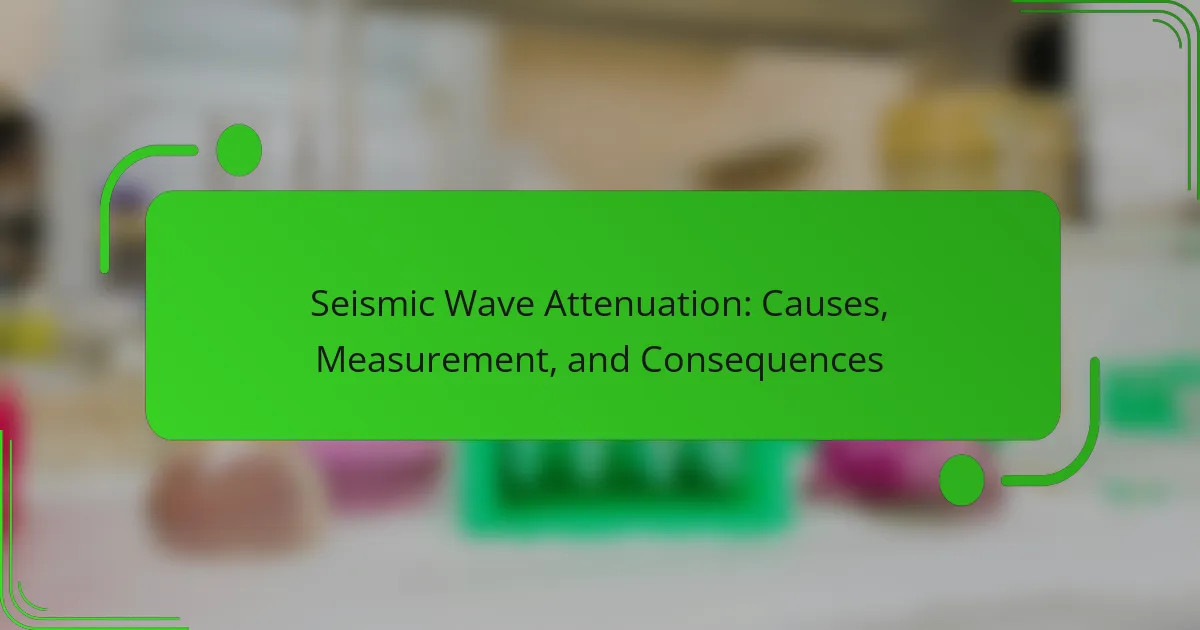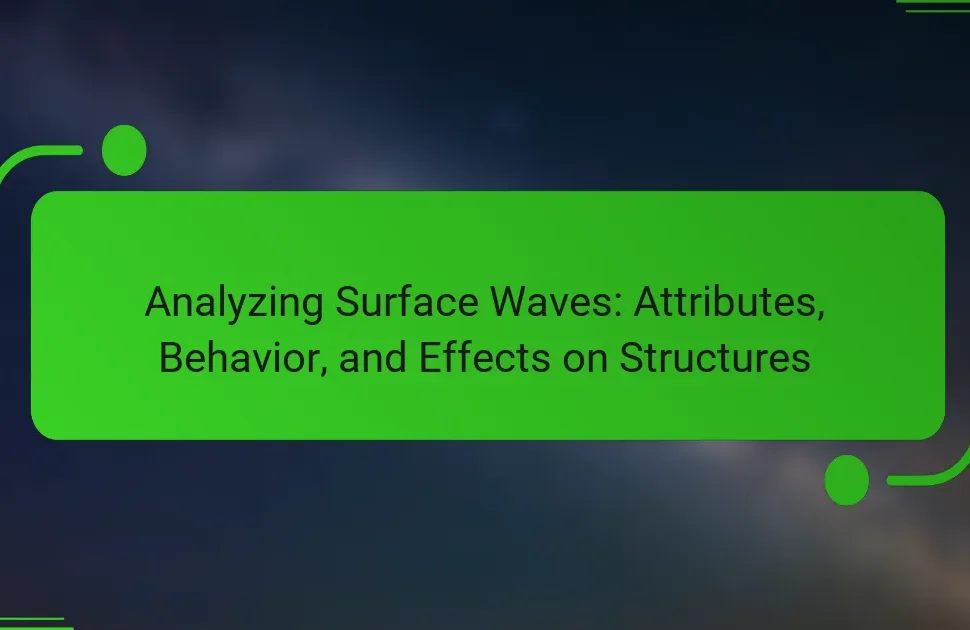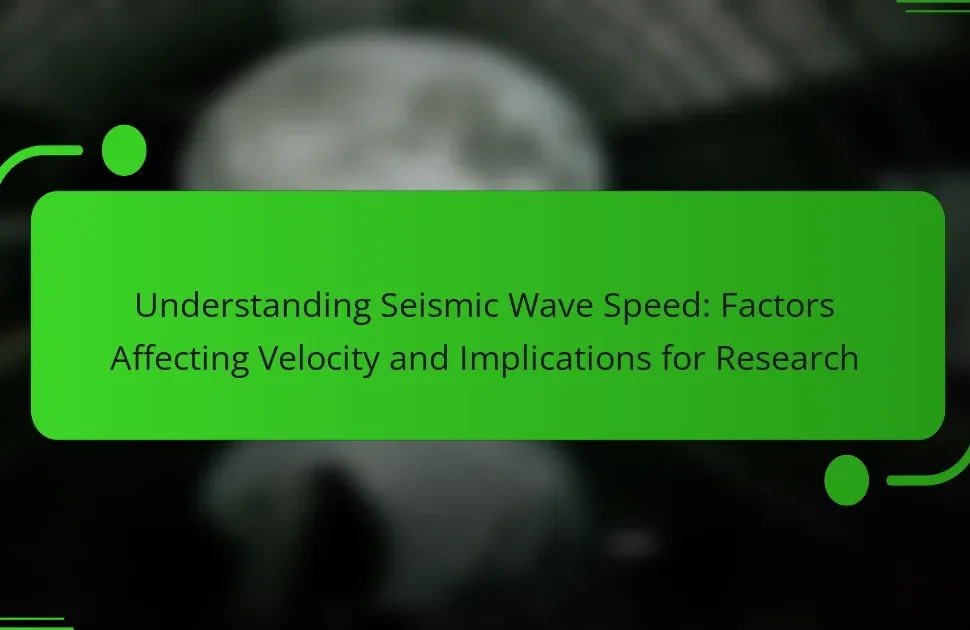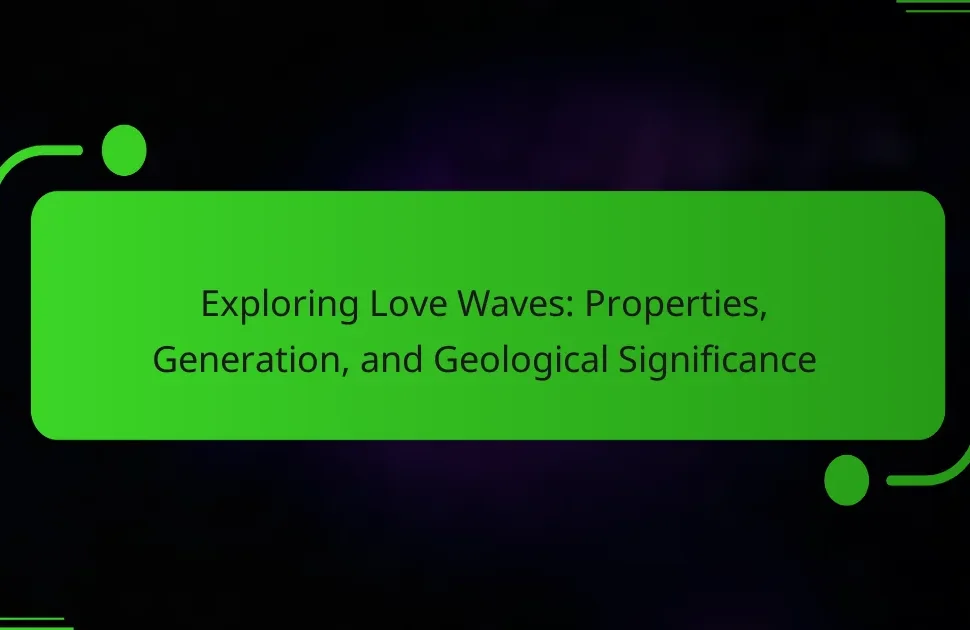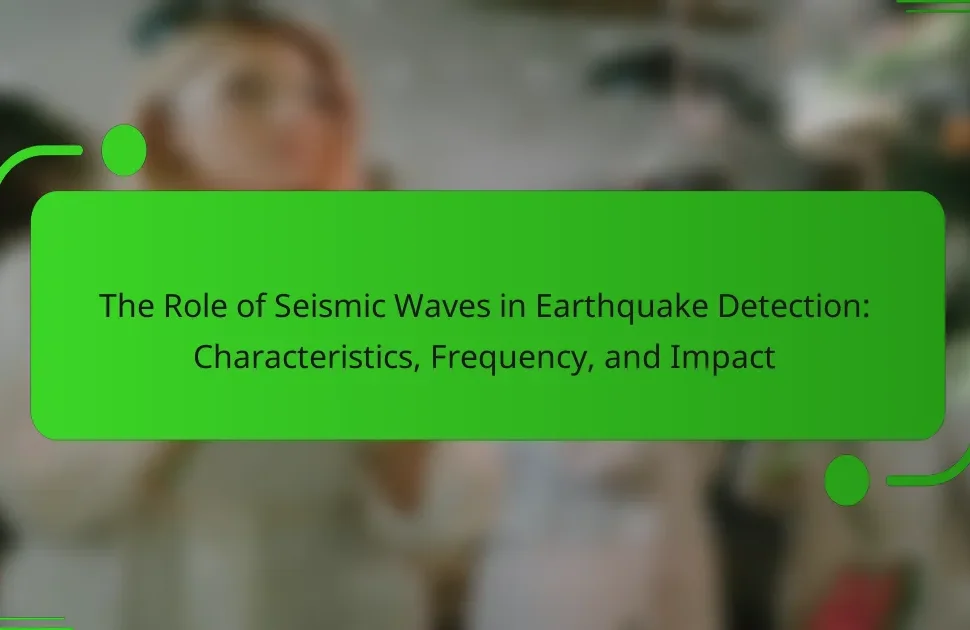Seismic wave attenuation refers to the reduction in amplitude of seismic waves as they travel through the Earth, influenced by factors such as energy absorption by geological materials and wave scattering from structural irregularities. This article explores the causes of seismic wave attenuation, including the impact of different rock and fluid types on wave behavior. It details measurement techniques, such as seismic data analysis and laboratory experiments, that quantify attenuation coefficients. The implications of seismic wave attenuation for data accuracy in earthquake detection, subsurface assessments, and emergency response planning are also examined, highlighting its significance in understanding seismic hazards and informing construction safety standards in earthquake-prone regions.
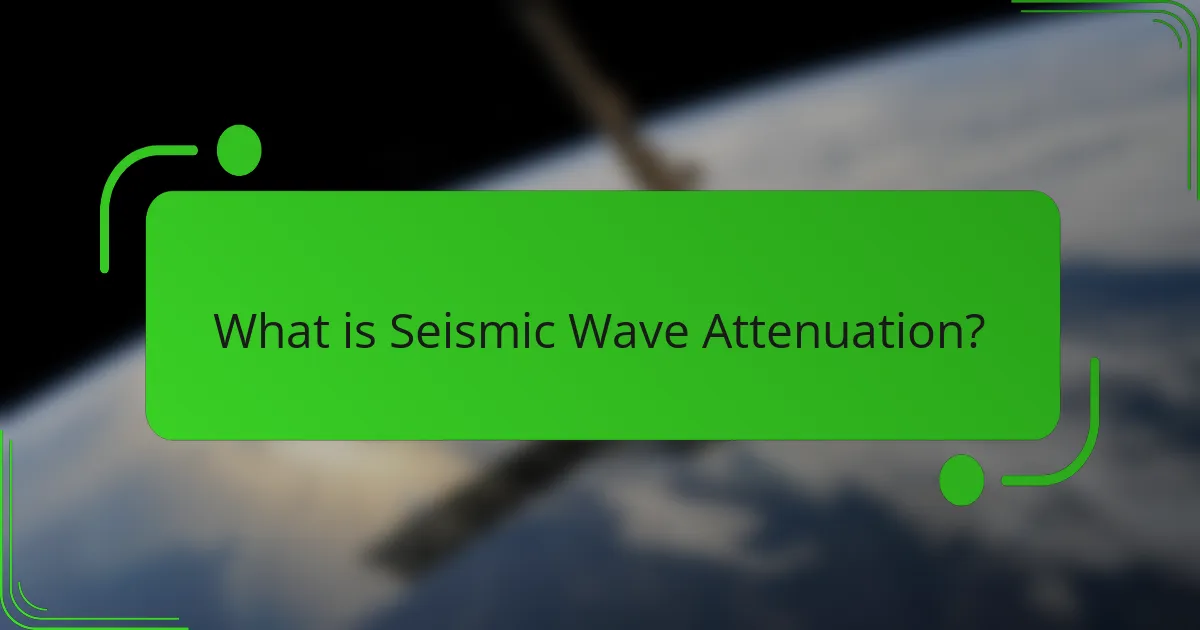
What is Seismic Wave Attenuation?
Seismic wave attenuation is the reduction in the amplitude of seismic waves as they travel through the Earth. This phenomenon occurs due to various factors, including the absorption of energy by geological materials. Additionally, scattering of waves caused by irregularities in the Earth’s structure contributes to attenuation. Studies show that the degree of attenuation varies based on the type of rock and fluid present in the subsurface. For example, seismic waves attenuate more in soft sediments compared to hard rock formations. Understanding seismic wave attenuation is crucial for accurately interpreting seismic data and assessing subsurface conditions.
How do seismic waves propagate through different mediums?
Seismic waves propagate through different mediums by transferring energy through vibrations. These waves can travel through solids, liquids, and gases, but their speed and behavior vary significantly. In solids, seismic waves move faster due to tightly packed particles, allowing efficient energy transfer. For example, P-waves (primary waves) can travel at speeds of 5 to 8 km/s in the Earth’s crust. In liquids, like water, seismic waves travel slower, as seen with S-waves (secondary waves) which cannot propagate in fluids. The speed of seismic waves in water is about 1.5 km/s. In gases, seismic waves travel even slower, typically around 0.34 km/s in air. The medium’s density and elasticity influence wave speed and attenuation. Denser materials generally facilitate faster wave propagation. This behavior is crucial for understanding seismic activity and assessing earthquake impacts.
What are the types of seismic waves involved in attenuation?
The types of seismic waves involved in attenuation are primary waves (P-waves) and secondary waves (S-waves). P-waves are compressional waves that travel fastest through the Earth’s interior. They can move through solids, liquids, and gases. S-waves are shear waves that follow P-waves. They only travel through solids and are slower than P-waves. Both wave types lose energy as they propagate through different geological materials. This energy loss is referred to as attenuation. Attenuation affects the amplitude and frequency of seismic waves, impacting the data collected during seismic studies.
How does the medium affect the propagation of seismic waves?
The medium significantly affects the propagation of seismic waves. Different materials transmit seismic energy at varying speeds. For instance, seismic waves travel faster in solid rock than in softer sediments. This speed difference influences wave arrival times at seismic stations. Additionally, the density and elasticity of the medium determine wave attenuation. Denser materials can absorb more energy, reducing wave amplitude. Conversely, less dense materials may allow waves to travel further with less attenuation. Research shows that seismic waves can reflect and refract at boundaries between different media. This behavior can create complex wave patterns that impact earthquake analysis.
What causes seismic wave attenuation?
Seismic wave attenuation is primarily caused by the scattering and absorption of seismic energy as waves travel through different geological materials. Scattering occurs when seismic waves encounter irregularities or heterogeneities in the subsurface, causing the energy to spread out. Absorption refers to the conversion of seismic energy into heat due to internal friction within the rocks. Factors such as the composition of the materials, porosity, and fluid content significantly influence these processes. Research indicates that higher frequencies tend to attenuate more rapidly than lower frequencies due to these mechanisms.
How do geological factors contribute to seismic wave attenuation?
Geological factors contribute to seismic wave attenuation through variations in rock properties and layering. Different materials absorb and scatter seismic energy differently. For example, soft sediments attenuate waves more than hard rocks. The presence of fractures and faults can also disrupt wave propagation. Additionally, changes in density and elasticity affect wave speed and energy loss. These factors collectively influence the amplitude and velocity of seismic waves as they travel through the Earth. Studies show that seismic waves lose energy more rapidly in heterogeneous geological formations compared to uniform ones.
What role does frequency play in seismic wave attenuation?
Frequency significantly influences seismic wave attenuation. Higher frequency waves typically experience greater attenuation compared to lower frequency waves. This occurs due to increased scattering and absorption in geological materials. For instance, high-frequency waves are more susceptible to energy loss through friction and inelastic deformation. Studies show that attenuation coefficients rise with frequency, indicating that seismic waves lose energy more rapidly at higher frequencies. This relationship affects the interpretation of seismic data and the design of structures in seismically active regions.
Why is understanding seismic wave attenuation important?
Understanding seismic wave attenuation is important because it affects how seismic waves travel through the Earth’s layers. Attenuation determines the energy loss of waves, impacting the accuracy of seismic data interpretation. Accurate data is crucial for assessing earthquake risks and designing resilient structures. Studies show that attenuation varies with geological conditions, influencing wave propagation speed and strength. For instance, research by Aki and Richards in “Quantitative Seismology” highlights the significance of attenuation in earthquake source characterization. Thus, understanding this phenomenon aids in improving seismic hazard assessments and enhancing public safety.
How does seismic wave attenuation impact earthquake analysis?
Seismic wave attenuation impacts earthquake analysis by affecting the energy loss of seismic waves as they travel through the Earth. This energy loss can influence the amplitude and frequency of the waves that are detected at the surface. Higher attenuation results in lower amplitudes, which can lead to underestimating the earthquake’s magnitude. Additionally, attenuation affects the duration of shaking experienced during an earthquake. Studies show that regions with higher attenuation may experience longer shaking times, which can influence building design and safety assessments. Understanding attenuation allows for better seismic hazard assessments and improved earthquake preparedness.
What are the implications for construction and infrastructure?
Seismic wave attenuation significantly impacts construction and infrastructure. It affects the design and durability of structures. Engineers must consider attenuation when assessing ground motion during earthquakes. This ensures buildings can withstand seismic forces. Poor understanding of attenuation can lead to inadequate structural designs. Such designs may result in increased damage during seismic events. Additionally, infrastructure like bridges and roads requires special materials to mitigate seismic effects. Overall, accounting for seismic wave attenuation is crucial for safety and resilience in construction.
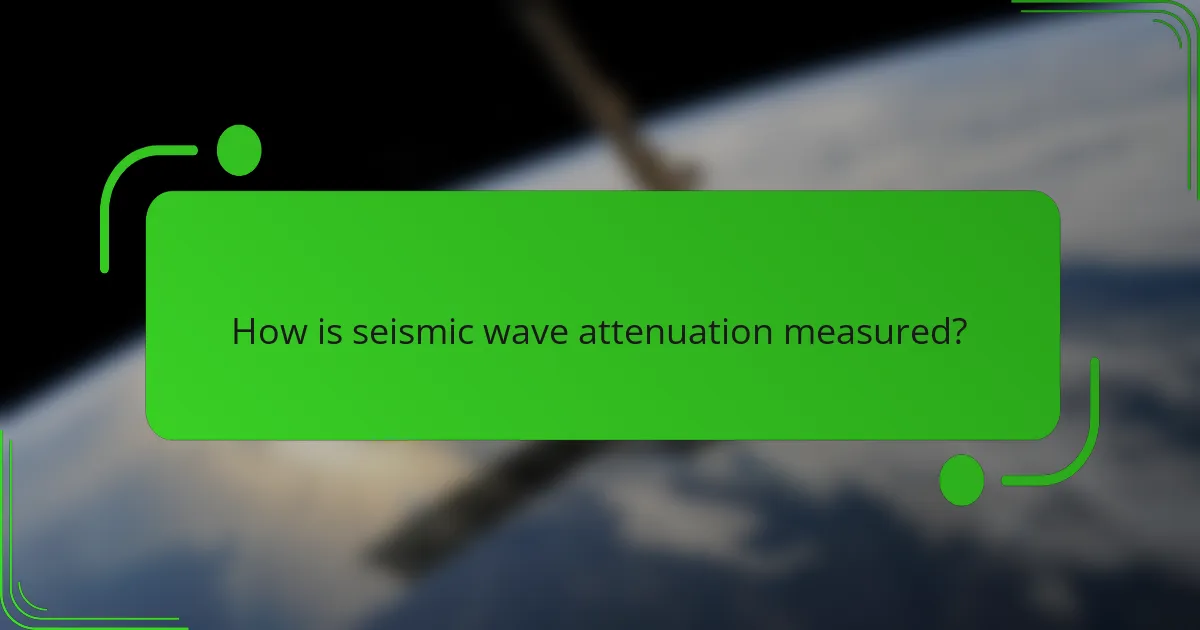
How is seismic wave attenuation measured?
Seismic wave attenuation is measured using various techniques, including the analysis of seismic data and laboratory experiments. One common method involves recording seismic waves as they travel through different geological materials. The amplitude of the waves decreases as they propagate, indicating attenuation.
Researchers often utilize seismic sensors to capture waveforms during earthquakes or controlled explosions. The data collected allows for the calculation of attenuation coefficients. These coefficients quantify the rate at which seismic energy diminishes with distance.
Laboratory tests on rock samples can also provide insights into attenuation properties. By applying controlled stress and measuring wave velocity, scientists can determine how different materials absorb seismic energy.
Studies have shown that attenuation varies with frequency and material type. For instance, higher frequencies typically experience greater attenuation in soft sediments compared to hard rock. This relationship is crucial for understanding seismic wave behavior in various geological settings.
What methods are used to measure seismic wave attenuation?
Seismic wave attenuation is measured using various methods. Common techniques include spectral analysis, which evaluates frequency content changes. Another method is time-domain analysis, focusing on the wave’s amplitude decay over time. Additionally, attenuation can be assessed through inverse modeling, which estimates material properties from observed waveforms. Laboratory experiments also provide insights by measuring wave propagation through controlled materials. Field measurements often utilize arrays of sensors to capture data from multiple locations. These methods collectively enhance understanding of seismic wave behavior in different geological contexts.
How does the quality factor (Q-factor) relate to attenuation measurements?
The quality factor (Q-factor) quantifies the attenuation of seismic waves. It measures the energy loss relative to the stored energy in a wave. A higher Q-factor indicates lower attenuation and less energy loss. Conversely, a lower Q-factor signifies higher attenuation and greater energy loss. Attenuation measurements assess how seismic waves decrease in amplitude as they travel through materials. The Q-factor is directly related to these measurements, as it provides a numerical value to describe the efficiency of wave propagation. Research indicates that Q-factors vary with frequency and material properties, influencing seismic wave behavior. Thus, understanding the Q-factor is essential for accurate attenuation assessments in seismic studies.
What technologies are employed in measuring seismic wave attenuation?
Seismic wave attenuation is measured using various technologies, including seismometers, accelerometers, and microseismic monitoring systems. Seismometers detect ground motion and provide data on wave amplitude and frequency. Accelerometers measure acceleration and help determine wave propagation characteristics. Microseismic monitoring systems capture low-frequency seismic events, providing insights into subsurface conditions. These technologies utilize advanced signal processing techniques to analyze waveforms. For example, Fourier analysis is often applied to assess frequency-dependent attenuation. Additionally, array configurations enhance spatial resolution, allowing for more accurate measurements. These methods collectively contribute to a comprehensive understanding of seismic wave behavior and attenuation in geological materials.
What challenges exist in measuring seismic wave attenuation?
Measuring seismic wave attenuation presents several challenges. One challenge is the variability of geological materials. Different rock types and structures can affect wave propagation differently. Another challenge is the complexity of wave interactions. Seismic waves can reflect, refract, and diffract, complicating the analysis. Additionally, measuring instruments may have limitations. Sensor sensitivity and frequency response can influence data accuracy. Environmental factors also play a role. Noise from surface activities can obscure seismic signals. Finally, data interpretation can be difficult. The need for advanced modeling techniques complicates the extraction of attenuation properties.
How do environmental conditions affect measurement accuracy?
Environmental conditions significantly impact measurement accuracy. Factors such as temperature, humidity, and pressure can alter the performance of measurement instruments. For instance, temperature fluctuations can affect the calibration of sensors, leading to erroneous data. High humidity levels may introduce moisture into electronic devices, causing malfunctions. Additionally, atmospheric pressure changes can influence the propagation of seismic waves, affecting readings. Research indicates that precise measurements require controlled environmental conditions to minimize errors. Studies show that temperature variations can lead to measurement deviations of up to 5%. Therefore, maintaining stable environmental conditions is crucial for accurate measurements in seismic studies.
What are the limitations of current measurement techniques?
Current measurement techniques for seismic wave attenuation have several limitations. They often lack the ability to capture high-frequency signals accurately. This can lead to an incomplete understanding of wave propagation. Additionally, many techniques are sensitive to environmental noise, which can distort results. The spatial resolution of some methods may not be sufficient for detailed analysis. Certain techniques also require extensive calibration, complicating their use in field conditions. Furthermore, the interpretation of data can be subjective, leading to variability in results. These limitations highlight the need for advancements in measurement technology.
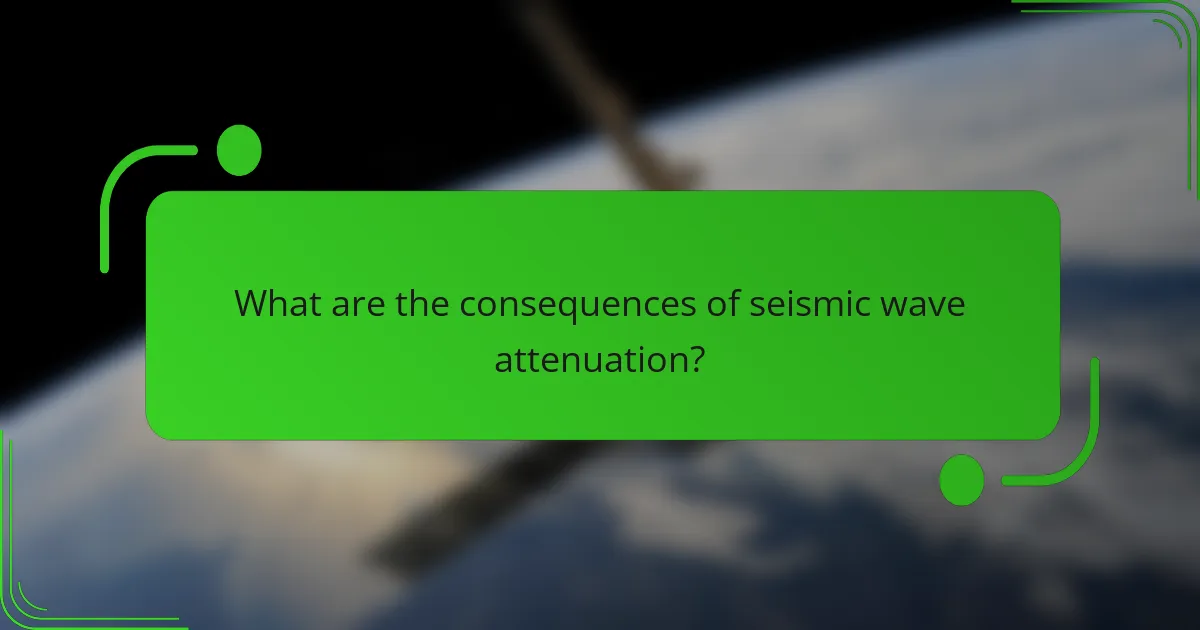
What are the consequences of seismic wave attenuation?
Seismic wave attenuation leads to reduced signal strength and clarity during seismic events. This phenomenon can result in less accurate data for earthquake detection and analysis. Attenuation affects the ability to determine the location and magnitude of seismic events. It can also hinder the assessment of subsurface geological structures. Additionally, attenuation can impact the effectiveness of seismic monitoring networks. As a consequence, emergency response planning may be less effective. Overall, seismic wave attenuation complicates our understanding of seismic hazards. This has implications for construction standards and safety regulations in earthquake-prone areas.
How does seismic wave attenuation affect earthquake detection?
Seismic wave attenuation affects earthquake detection by reducing the amplitude and energy of seismic waves as they travel through the Earth. This reduction can hinder the ability of seismic instruments to accurately detect and measure earthquakes. As seismic waves lose energy, the distance they can effectively travel decreases. Consequently, this can result in missed detections of smaller earthquakes. Research indicates that significant attenuation occurs in certain geological formations, which can obscure signals from distant seismic events. For instance, studies show that urban areas with complex geology exhibit higher attenuation, complicating earthquake monitoring efforts. Thus, understanding seismic wave attenuation is crucial for improving earthquake detection accuracy.
What are the implications for early warning systems?
Early warning systems are crucial for disaster risk reduction. They provide timely alerts about impending seismic events. This allows for proactive measures to be taken. For instance, evacuations can be initiated to save lives. Additionally, infrastructure can be reinforced or shut down to prevent damage. Research shows that effective early warning systems can reduce fatalities by up to 50%. The integration of seismic wave attenuation data enhances the accuracy of these systems. This leads to better prediction of ground shaking and its impact. Overall, the implications are significant for public safety and emergency preparedness.
How does attenuation influence seismic hazard assessment?
Attenuation influences seismic hazard assessment by determining how seismic waves lose energy as they travel through the Earth. This energy loss affects the ground motion experienced at various distances from the earthquake source. As attenuation increases, the intensity of shaking decreases, which can alter hazard estimates. Accurate models of attenuation help in predicting the potential impact of seismic events on structures. Studies show that regions with high attenuation may experience less damage compared to areas with low attenuation. For instance, the use of the empirical attenuation relationship derived from local seismic data improves hazard models. This relationship quantifies how distance and local geological conditions affect wave propagation. Hence, understanding attenuation is crucial for effective seismic hazard assessment and risk mitigation.
What are the broader impacts of seismic wave attenuation on society?
Seismic wave attenuation significantly impacts society by influencing earthquake preparedness and response. It affects the design and construction of buildings. Engineers use attenuation data to create structures that can withstand seismic forces. This reduces potential damage and saves lives during earthquakes.
Additionally, seismic wave attenuation informs land-use planning. Authorities can identify areas at higher risk and implement regulations. This proactive approach minimizes economic losses and enhances community resilience.
Moreover, understanding attenuation aids in the development of early warning systems. These systems rely on real-time data to alert populations before seismic waves arrive. Timely warnings can lead to life-saving actions, such as evacuations or securing hazardous materials.
Overall, the broader impacts of seismic wave attenuation are critical for enhancing public safety, economic stability, and urban planning.
How does seismic wave attenuation affect public safety during earthquakes?
Seismic wave attenuation directly impacts public safety during earthquakes by reducing the intensity of ground shaking. Attenuation occurs as seismic waves travel through different geological materials. Softer materials absorb and dissipate energy, leading to less destructive shaking. This phenomenon can lessen the risk of structural damage and injury. For instance, studies show that urban areas with softer soils experience lower peak ground accelerations. Consequently, effective seismic wave attenuation can enhance building resilience. Understanding local geological conditions can inform construction practices. This knowledge ultimately aids in disaster preparedness and risk mitigation.
What are the economic implications of seismic wave attenuation on urban planning?
Seismic wave attenuation affects urban planning by influencing construction costs and safety measures. Areas with high attenuation can reduce the impact of seismic waves on structures. This leads to lower costs for earthquake-resistant designs. Conversely, regions with low attenuation may require more robust and expensive engineering solutions. Urban planners must consider these factors when designing infrastructure. The economic implications also extend to insurance premiums, which may be higher in areas with low attenuation. Additionally, property values can fluctuate based on perceived seismic risk. Overall, understanding seismic wave attenuation is crucial for effective urban planning and economic stability.
What best practices can be adopted regarding seismic wave attenuation?
Implementing best practices for seismic wave attenuation involves optimizing building materials and structural design. Utilizing materials with high damping properties can effectively reduce seismic wave energy. Incorporating base isolation techniques allows structures to move independently of ground motion. Regularly assessing the geological characteristics of the site aids in understanding wave propagation. Employing advanced modeling techniques can predict seismic responses accurately. Retrofitting older structures with modern technology enhances their resilience to seismic events. Continuous monitoring and maintenance of structures ensure long-term effectiveness. These practices are supported by studies indicating reduced damage during seismic events when applied correctly.
How can engineers mitigate the effects of seismic wave attenuation in construction?
Engineers can mitigate the effects of seismic wave attenuation in construction by using advanced materials and design techniques. Implementing base isolation systems allows structures to move independently of ground motion. This reduces the energy transferred during seismic events. Reinforced concrete and steel frames enhance the structural integrity against seismic forces. Additionally, engineers may employ damping systems to absorb and dissipate energy. Proper site selection and soil stabilization techniques can also minimize attenuation effects. Research indicates that these methods significantly improve a building’s resilience to earthquakes. For example, a study by the National Institute of Standards and Technology (NIST) highlights the effectiveness of base isolators in reducing seismic impact.
What strategies can be implemented for better seismic hazard preparedness?
Implementing better seismic hazard preparedness involves several key strategies. First, conducting regular seismic risk assessments is essential. These assessments identify vulnerabilities in infrastructure and communities. Second, developing and enforcing building codes that require earthquake-resistant designs is crucial. Studies show that compliant structures significantly reduce damage during seismic events. Third, educating the public on earthquake safety measures enhances community resilience. Programs that teach drop, cover, and hold on techniques are effective. Fourth, creating emergency response plans ensures quick action during an earthquake. Research indicates that communities with established plans recover faster. Finally, investing in early warning systems can provide critical seconds for people to take cover. These strategies collectively improve preparedness and reduce the impact of seismic hazards.
Seismic wave attenuation is the reduction in amplitude of seismic waves as they travel through different geological materials, influenced by factors such as energy absorption and scattering. This article explores the causes of seismic wave attenuation, including the impact of geological factors and frequency on wave behavior. It also discusses measurement techniques, challenges, and the implications of attenuation for earthquake detection, hazard assessment, and construction practices. Understanding seismic wave attenuation is crucial for improving public safety and enhancing the resilience of infrastructure in earthquake-prone areas.
